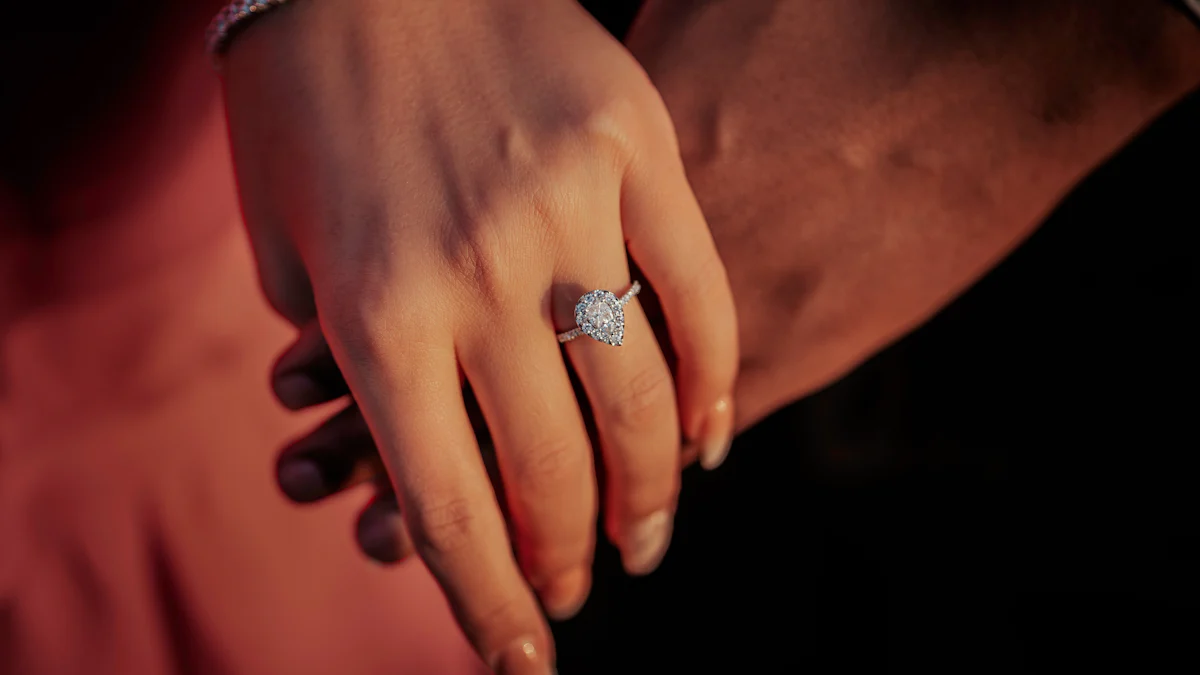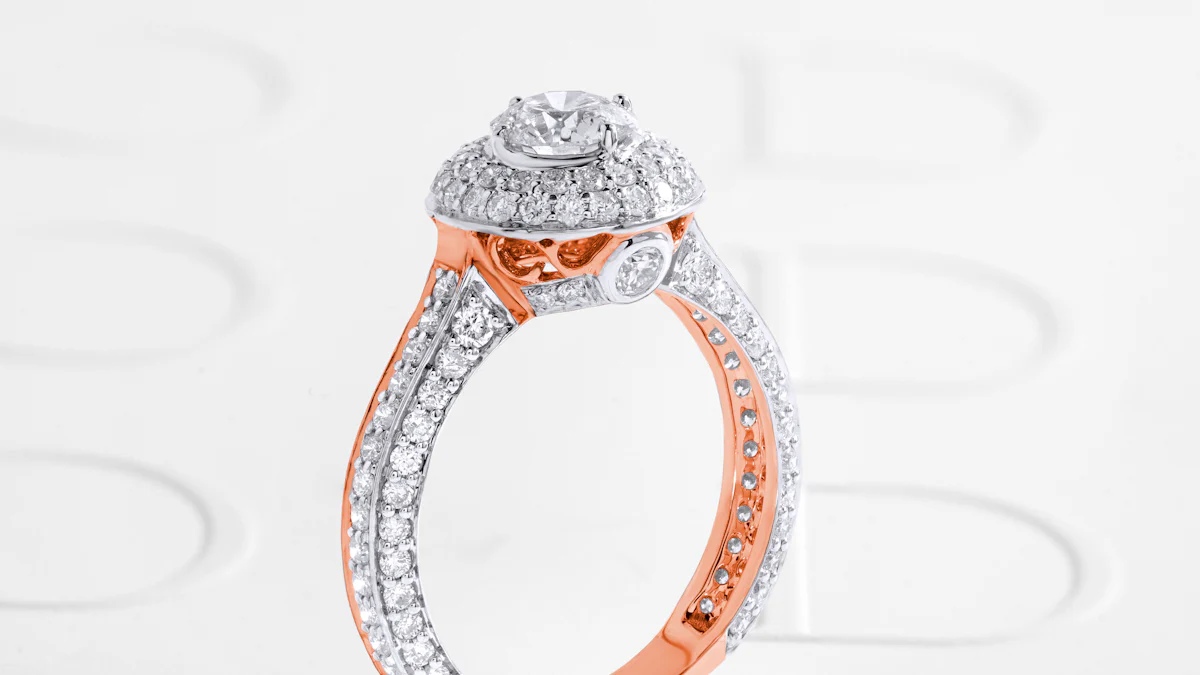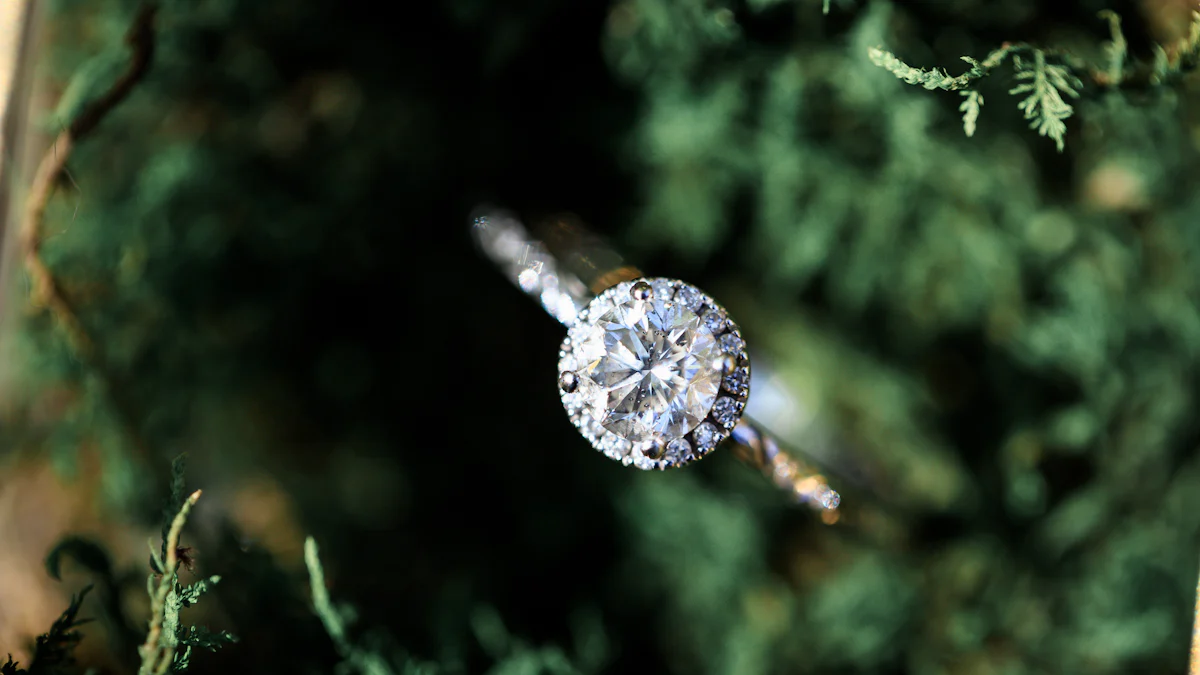Tips for Buying a 1 2 Ct Diamond Ring in 2024

Choosing a high-quality 1 2 ct diamond ring is more than just a purchase; it’s a meaningful investment in love and commitment. A diamond, even at 1 2 ct, carries immense emotional value. Its brilliance and rarity symbolize the depth of your feelings. In 2024, making an informed decision matters more than ever. Diamond prices have steadily risen, reflecting their enduring appeal. By understanding what makes a diamond exceptional, you ensure your choice becomes a timeless treasure. A well-chosen 1 2 ct diamond ring can hold the same magic as larger stones, proving that quality always outshines size.
Key Takeaways
- Set a realistic budget before shopping to avoid overspending and ensure you get the best value for your money.
- Understand the 4Cs of diamonds—cut, color, clarity, and carat—to make informed choices that enhance the beauty and value of your ring.
- Choose a diamond shape and setting that reflects the wearer's personality, balancing timeless styles with modern trends.
- Consider lab-grown diamonds for a more affordable and ethical option, offering the same beauty as natural diamonds at a lower price.
- Opt for diamonds slightly under popular carat weights to save money without sacrificing appearance, as the size difference is often negligible.
- Always purchase certified diamonds to guarantee quality and authenticity, protecting your investment and ensuring peace of mind.
- Plan for long-term maintenance and after-sales support from your jeweler to keep your diamond ring in pristine condition.
Setting a Budget and Understanding the 4Cs
How to Set a Realistic Budget for a 1 2 Ct Diamond Ring
Setting a budget is the first step in buying a 1 2 ct diamond ring.
When setting your budget, think about what matters most to you. Do you prioritize the diamond’s quality, size, or overall design? For example, if you value quality, you might choose a smaller diamond with excellent cut and clarity. On the other hand, if size is your priority, you could opt for a slightly larger diamond with acceptable quality.
“Illustrates three options for a buyer within a given budget: Option 1 shows the types of diamonds based on highest quality, Option 2 highlights diamonds for quality and optimal value, and Option 3 shows diamonds with the biggest carat weight and acceptable quality.”
This approach ensures you get the best value for your money. Remember, a well-thought-out budget keeps you on track and makes the shopping process less stressful.
The 4Cs of Diamonds: Cut, Color, Clarity, and Carat
Understanding the 4Cs—cut, color, clarity, and carat—is essential when choosing a 1 2 ct diamond ring. These factors determine the diamond’s beauty and value. Let’s break them down:
-
Cut: The cut affects how a diamond sparkles. A well-cut diamond reflects light beautifully, making it appear more brilliant. Always prioritize cut quality over other factors. Even a smaller diamond with an excellent cut can outshine a larger one with a poor cut.
-
Color: Diamonds range from colorless to light yellow. Colorless diamonds are more valuable because they allow more light to pass through, enhancing their brilliance. For a 1 2 ct diamond ring, aim for a diamond in the near-colorless range (G-H) to balance beauty and cost.
-
Clarity: Clarity refers to the presence of imperfections, called inclusions. Most inclusions are invisible to the naked eye, so you don’t need a flawless diamond. Look for a diamond with a clarity grade of VS1 or VS2 for a clean appearance without overspending.
-
Carat: Carat measures the diamond’s weight. While carat size is important, it’s not the only factor. A well-cut 1 2 ct diamond can look just as stunning as a larger diamond. You can also save money by choosing a diamond slightly under 0.50 carats, as it will appear nearly identical in size.
By understanding the 4Cs, you can make informed decisions and find a diamond that fits your preferences and budget. Each “C” plays a role in creating a ring that feels perfect for you.
Selecting the Right Diamond Shape, Style, and Setting

Choosing the perfect diamond shape for your 1 2 ct diamond ring can make all the difference.
Popular Diamond Shapes for a 1 2 Ct Diamond Ring
The shape of a diamond plays a significant role in its appearance and how it reflects light. Some shapes are timeless, while others cater to modern tastes. Here are a few popular options:
- Round: The round brilliant cut is the most sought-after shape. Its symmetrical design maximizes sparkle, making it a classic choice for any style or setting. Whether you prefer a simple solitaire or a halo setting, a round diamond fits beautifully.
- Princess: This square-shaped diamond offers a contemporary look with sharp edges and excellent brilliance. It’s ideal for those who want a modern yet elegant design.
- Oval: Oval diamonds elongate the finger and provide a unique twist on the traditional round shape. Their elongated form enhances the diamond’s size, making a 1 2 ct diamond ring appear larger.
- Cushion: With its rounded corners and soft square shape, the cushion cut combines vintage charm with modern appeal. It’s perfect for those who love a romantic and timeless aesthetic.
Each shape has its own charm. Think about what resonates most with you or the person who will wear the ring. A well-chosen shape can elevate the beauty of a 1 2 ct diamond ring.
Engagement Ring Styles and Settings
The setting of a diamond ring not only secures the stone but also enhances its overall design. Here are some popular styles and settings to consider:
- Solitaire: A single diamond takes center stage in this classic style. It’s simple, elegant, and timeless, allowing the diamond’s brilliance to shine without distractions.
- Halo: A circle of smaller diamonds surrounds the center stone, adding extra sparkle and making the diamond appear larger. This style works beautifully with a 1 2 ct diamond ring.
- Pavé: Tiny diamonds line the band, creating a glittering effect. This setting adds sophistication and complements the center stone.
- Three-Stone: Featuring a central diamond flanked by two smaller stones, this style symbolizes the past, present, and future. It’s a meaningful choice for an engagement ring.
- Bezel: A metal rim encircles the diamond, offering a sleek and modern look. This setting provides excellent protection for the stone.
When selecting a setting, think about practicality and lifestyle. For example, if the wearer leads an active life, a bezel or low-profile setting might be more suitable.
Aligning the Ring with Personal Preferences and Trends
A diamond ring should reflect the wearer’s personality and style. Consider their preferences when choosing the shape, setting, and overall design. Do they prefer something classic or modern? Are they drawn to bold designs or understated elegance?
In 2024, trends lean toward personalization. Many buyers opt for unique combinations of diamond shapes and settings to create one-of-a-kind rings. Mixing metals, such as pairing white gold with rose gold accents, is also gaining popularity. Additionally, lab-grown diamonds are becoming a preferred choice for their ethical and sustainable appeal.
“A diamond ring is more than jewelry; it’s a reflection of love and individuality.”
Take your time to explore different options. Whether you follow trends or stick to timeless designs, the goal is to find a ring that feels special and meaningful.
Maximizing Value When Buying a 1 2 Ct Diamond Ring

When shopping for a 1 2 ct diamond ring, getting the most value for your money is key. By exploring smart options and making informed choices, you can find a stunning ring that fits your budget without compromising on quality.
Benefits of Lab-Grown Diamonds
Lab-grown diamonds have become a popular choice for many buyers. These diamonds are created in controlled environments using advanced technology, making them chemically and physically identical to natural diamonds. The best part? They often cost up to 50% less than mined diamonds of the same size and quality. This affordability allows you to invest in a larger or higher-quality diamond without exceeding your budget.
Another advantage of lab-grown diamonds is their ethical and sustainable appeal. Unlike mined diamonds, they don’t involve harmful mining practices or questionable labor conditions. Their origins are traceable, giving you peace of mind about your purchase. Additionally, lab-grown diamonds have a smaller environmental footprint, making them an excellent choice for eco-conscious buyers.
“Lab-grown diamonds offer a perfect blend of beauty, affordability, and sustainability, making them a compelling option for modern consumers.”
While some critics point out that the production process of lab-grown diamonds can be energy-intensive, advancements in technology continue to improve their environmental impact. If you’re looking for a diamond that aligns with your values and budget, lab-grown options are worth considering.
Saving Money by Choosing Slightly Under Benchmark Carat Weights
Carat weight plays a significant role in a diamond’s price. However, you can save money by choosing a diamond that weighs slightly less than the benchmark carat weights. For example, instead of a 0.50-carat diamond, consider one that weighs 0.48 or 0.49 carats. The difference in size is nearly impossible to notice, but the price difference can be substantial.
This strategy works because diamond prices increase significantly at popular carat weights, such as 0.50 or 1.00 carats. By opting for a diamond just below these thresholds, you get a similar look at a lower cost. Combine this approach with a high-quality cut, and your 1 2 ct diamond ring will still shine brilliantly.
“A well-cut diamond under the benchmark weight can appear just as dazzling as a larger one, proving that smart choices lead to great value.”
Choosing the Right Metal for the Band
The metal you choose for the band can greatly influence the overall look and durability of your 1 2 ct diamond ring. Popular options include gold, platinum, and white gold. Each metal has its unique qualities, so it’s important to pick one that suits your style and lifestyle.
- Gold: Available in yellow, white, and rose tones, gold offers versatility and timeless appeal. White gold pairs beautifully with diamonds, enhancing their brilliance, while rose gold adds a romantic touch.
- Platinum: Known for its durability and hypoallergenic properties, platinum is an excellent choice for those with sensitive skin. Its natural white sheen complements diamonds perfectly and requires minimal maintenance.
- Mixed Metals: Mixing metals, such as combining white gold with rose gold accents, is a growing trend. This approach adds a modern twist to traditional designs and allows for more personalization.
When selecting a metal, consider the wearer’s lifestyle. For someone with an active lifestyle, platinum or a sturdy gold band may be more practical. The right metal not only enhances the diamond’s beauty but also ensures the ring lasts for years to come.
“The perfect band complements the diamond and reflects the wearer’s personality, creating a harmonious and meaningful design.”
Avoiding Common Mistakes When Buying a 1 2 Ct Diamond Ring
Mistakes during the diamond-buying process can lead to regret or unnecessary expenses. By staying informed and cautious, you can avoid common pitfalls and make a confident purchase.
Importance of Buying Certified Diamonds
Always insist on purchasing a certified diamond. Certification ensures that the diamond has been independently graded by a reputable gemological laboratory, such as GIA (Gemological Institute of America) or AGS (American Gem Society). These certificates verify the diamond’s quality based on the 4Cs—cut, color, clarity, and carat weight. Without certification, you risk overpaying for a diamond that may not meet your expectations.
Certified diamonds provide peace of mind. They confirm that the diamond is authentic and accurately graded. For example, a jeweler might claim a diamond has excellent clarity, but without certification, there’s no way to verify this. Certification protects you from such misrepresentations.
Pro Tip: Always ask for the diamond’s certificate before making a purchase. If a jeweler hesitates to provide one, consider it a red flag.
Whether you’re buying a natural or lab-grown diamond, certification is non-negotiable. It guarantees that you’re getting what you paid for and ensures the diamond’s value and authenticity.
Viewing the Diamond in Person or Online Alternatives
Seeing the diamond in person allows you to assess its brilliance, sparkle, and overall appearance. Lighting conditions and angles can affect how a diamond looks, so viewing it firsthand helps you make an informed decision. Pay attention to how the diamond reflects light and whether it meets your expectations.
If visiting a store isn’t possible, online alternatives can still provide a reliable experience. Many reputable online jewelers offer high-resolution images and videos of their diamonds. Some even provide 360-degree views, allowing you to examine the diamond from every angle. Look for retailers with transparent return policies and customer reviews to ensure a trustworthy purchase.
Quick Tip: When shopping online, choose retailers that offer detailed diamond certifications and clear visuals. This ensures you’re not relying solely on descriptions.
Whether in person or online, take your time to evaluate the diamond. Rushing the process can lead to mistakes, so prioritize thoroughness over speed.
Considering Long-Term Maintenance and After-Sales Service
A diamond ring is a long-term investment, so consider its maintenance and the after-sales services offered by the jeweler. Over time, rings may require cleaning, resizing, or repairs. Choosing a jeweler with excellent after-sales support ensures your ring stays in top condition.
Ask about warranties or service plans. Some jewelers offer free lifetime cleaning or inspections, which can save you money in the long run. Also, inquire about resizing policies, especially if you’re unsure about the ring size. A jeweler with flexible services makes ownership easier and more enjoyable.
Did You Know? Regular cleaning and inspections help maintain your diamond’s brilliance and prevent potential damage.
By planning for maintenance and choosing a jeweler with strong after-sales support, you protect your investment and ensure your ring remains as stunning as the day you bought it.
Finding the perfect diamond ring is all about making informed choices. By understanding the 4Cs, you ensure the diamond’s quality matches your expectations. Selecting the right style and setting adds a personal touch that reflects individuality. Maximizing value through smart decisions, like considering lab-grown diamonds or slightly under benchmark weights, helps you stay within budget. Avoiding common mistakes, such as skipping certification, guarantees confidence in your purchase.
Take your time, research thoroughly, and focus on what matters most to you. The joy of discovering the ideal ring makes the effort worthwhile. Your perfect ring awaits!
FAQ
What Should You Consider Before Buying a Diamond?
You should always ask about the diamond's origin. Knowing where it comes from ensures you’re making an ethical purchase.
"Your diamond should symbolize love, not conflict. Always verify its origin to make an informed choice."
Are Lab-Grown Diamonds as Good as Natural Diamonds?
Yes, lab-grown diamonds are just as beautiful and durable as natural ones. They share the same physical, chemical, and optical properties. The main difference lies in their origin. Lab-grown diamonds are created in controlled environments, making them more affordable and sustainable. If you’re looking for a budget-friendly and eco-conscious option, lab-grown diamonds are worth considering.
How Can You Tell If a Diamond Is Certified?
Certified diamonds come with a grading report from reputable labs like GIA or AGS.
Pro Tip: Keep the certificate safe. It’s essential for insurance and resale purposes.
What’s the Best Diamond Shape for a 1/2 Carat Ring?
The best shape depends on personal preference. Round diamonds are classic and maximize sparkle. Princess cuts offer a modern, edgy look. Oval shapes make the diamond appear larger, while cushion cuts add vintage charm. Choose a shape that resonates with your style or the wearer’s personality.
How Do You Save Money When Buying a Diamond?
You can save money by choosing a diamond slightly under popular carat weights. For example, a 0.48-carat diamond looks almost identical to a 0.50-carat one but costs less. Opting for near-colorless diamonds (G-H range) or diamonds with VS1 or VS2 clarity can also reduce costs without compromising beauty.
"Smart choices like these help you get the most value for your money."
Should You Buy a Diamond Online or In-Store?
Both options have pros and cons. Buying in-store lets you see the diamond’s brilliance and sparkle firsthand. Online retailers often offer better prices and a wider selection. If shopping online, choose reputable jewelers with high-resolution images, videos, and clear return policies. Take your time to evaluate the diamond thoroughly.
What’s the Importance of the 4Cs When Buying a Diamond?
The 4Cs—cut, color, clarity, and carat—determine a diamond’s beauty and value. Cut affects sparkle, so prioritize it. Colorless diamonds (D-F) are the most valuable, but near-colorless (G-H) offers great value. Clarity ensures the diamond looks clean, while carat impacts size. Understanding these factors helps you make an informed decision.
How Do You Choose the Right Metal for the Band?
The metal sets the tone for the ring’s overall look. White gold enhances the diamond’s brilliance, while rose gold adds warmth and romance. Platinum is durable and hypoallergenic, making it ideal for sensitive skin. Consider the wearer’s lifestyle and preferences when selecting the metal.
Why Is Certification Non-Negotiable?
Certification ensures you’re getting what you pay for. It verifies the diamond’s quality and authenticity. Without it, you risk overpaying for a subpar diamond. Always insist on a certificate from a trusted lab like GIA or AGS. It’s your assurance of the diamond’s true value.
How Do You Maintain a Diamond Ring?
Regular cleaning keeps your diamond sparkling. Use a soft brush and mild soap to clean it at home. Schedule professional cleanings and inspections to check for loose settings. Many jewelers offer free lifetime cleaning or maintenance plans. Proper care ensures your ring stays stunning for years.
"A little care goes a long way in preserving your diamond’s brilliance."
See Also
Essential Elements That Influence Diamond Ring Costs
Comprehensive Process for Selecting a White Diamond Ring
Comparison of Prices for All Around Diamond Rings

